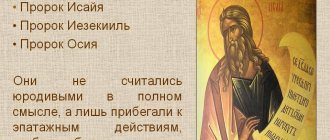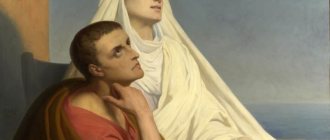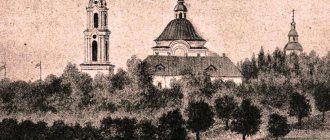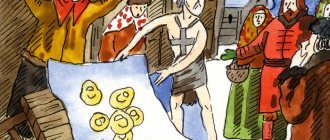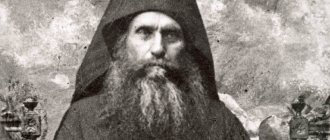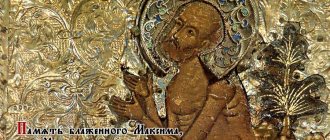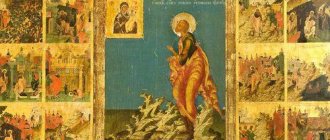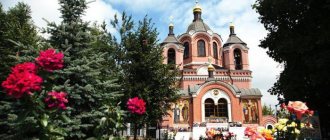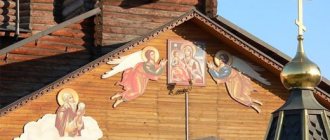Life of Blessed Isidore of Rostov
Saint Blessed Isidore was born in Prussia in the vicinity of the city of Brandenburg, the son of noble and wealthy parents professing Catholicism. According to legend, he was a close relative of the Grand Master of the German Order and participated in the Crusades. We do not know the circumstances under which the former German knight acquired the true Orthodox faith, and then moved to the Russian land in the middle of the 15th century. Having left his home, he, dressed in rags and with a staff in his hands, walked through many countries and villages until he finally stopped in the city of Rostov.
For many centuries, Rostov the Great was the center of the northeastern possessions of Russian princes and from ancient times was widely famous for its churches and monasteries, in which holy monks and wonderworkers labored. Here Blessed Isidore converted to Orthodoxy and took upon himself a special feat - foolishness for Christ's sake. Under the guise of a madman, he boldly exposed human sins and vices, especially those of the rich and powerful, humbly endured beatings and ridicule of unreasonable townspeople, endured hunger and cold, and was deprived of all earthly consolation. The saint remained in extreme poverty all his life; he settled in a wretched hut made of brushwood, which he himself built on an island in the middle of a city swamp. He retired here for night prayer, and spent his days acting like a fool in the streets. Thanks to his exploits, Isidore was awarded the gift of miracles and clairvoyance; the Rostovites nicknamed him “Terdislov” because his predictions always came true.
Blessed Isidore foresaw his departure to the Lord in advance and, a few days before his death, shut himself up in a hut for intense prayer. He reposed on May 14, 1474 (according to other sources - May 14, 1484). A certain passer-by, who was not far from the cell of the saint of God, felt a wonderful fragrance emanating from it and, when he went inside, he saw Isidore lying on the ground with his hands folded crosswise on his chest. Blessed Isidore was buried in the very place where his hut stood, and a wooden temple was soon built over his grave in honor of the Ascension of the Lord, since the day of Isidore’s burial, May 18, then coincided with the eve of this holiday.
Blessed Isidore, Fool for Christ's sake, Rostov WonderworkerMemorial Day: May 14
Blessed Isidore, the Fool for Christ's sake, the Rostov Wonderworker, was born in Germany, in the vicinity, probably, of Brennabor (or Brannibor, now Brandenburg) into a wealthy Slavic family of the Catholic faith. Already in his early youth, distinguished by his purity and mercy, Saint Isidore distributed his wealth to the poor and left his parental home for the sake of the Kingdom of Heaven. Having taken upon himself the feat of foolishness for Christ's sake, he, in rags and with a staff in his hand, set off on a long journey through many cities and countries, enduring ridicule, mockery, and sometimes even beatings everywhere. The last country on the path of his wanderings was Russia. Blessed Isidore converted to Orthodoxy and settled in Rostov the Great. Having built himself an uncovered hut from brushwood on a swampy wasteland within the city, the holy saint of God performed long night prayers in it. He spent his days on the city streets, humbly enduring all the hardships and reproaches with fervent prayer for his offenders. The saint slept very little during the day and only on a pile of manure or on damp earth. Inspired in his arduous deeds by ardent love for God, he endured all bitterness and sorrow with such zeal that with his patience he became like the ancient Job. And the Lord glorified such unhypocritical love of the ascetic with the gift of miracles. Once, blessed Isidore saved a Rostov merchant from imminent death, who was thrown into the raging sea by lot by his fellow travelers. The ship was caught by a sudden storm, and those sailing on it, like the companions of the prophet Jonah, decided to draw lots to find out whose sins were in danger and throw the culprit into the sea. Finding himself on a small board in stormy waves, the merchant almost lost hope of salvation when suddenly blessed Isidore appeared before his eyes, walking on water as if on dry land. Miraculously, Blessed Isidore returned the merchant to the ship and ordered him to explain to everyone the miraculous deliverance from death by the power of Divine mercy. Subsequently, during a chance meeting on one of the Rostov streets with the merchant he had saved, he again urgently demanded not to divulge the secret of his miraculous intercession, but to give thanks to God. Another story has been preserved about the gift of miracles of Blessed Isidore. One day, blessed Isidore came to the court of the Rostov prince at the moment when he was receiving the bishop, and asked one of the guards for water to quench his thirst, but was rudely expelled from the princely palace. Meanwhile, the servants sent by the prince to fetch water for the table were quite surprised to find all the vessels with previously stored water completely empty. When the prince was informed about the rough treatment of the holy fool, he severely punished his guard, ordered to find blessed Isidore and beg him to come to the palace. Soon the saint of God was brought to the prince. He entered with a large prosphora in his hands, which he presented to the bishop with the words: “Take, O saint, this prosphora, which I have at this very hour received from the hand of His Holiness the Metropolitan in Kyiv, in the Church of St. Sophia.” To everyone’s surprise, all the empty vessels turned out to be refilled with clean spring water. And it became clear to everyone that his words about the miraculous transfer to Kiev and the instant return with prosphora to Rostov were not a figment of the imagination of the blessed one, whom the angel of God really delighted, like Saint George, abbot of Mount Sinai (delighted from his cell to Jerusalem and returned back after communion of the Holy Mysteries of Christ from the hands of His Holiness Patriarch Peter). Contemporaries of Blessed Isidore, who were more than once convinced of the fulfillment of his predictions, called the saint “Tverdislov.” A particularly striking confirmation of the correctness of this nickname is the episode when Blessed Isidore appeared at the height of the wedding celebration on the occasion of the wedding of Prince Savva Obolensky and Princess Daria Lukhovskaya and, approaching the newlywed, handed him a personally woven wreath of wildflowers with the words: “Here for you, Prince, and a bishop's hat." The mysterious meaning of the words spoken surprised the newlyweds and their guests, but the ambiguity of the saint’s predictions soon reassured everyone. And yet, the act of Blessed Isidore and his words turned out to be evidence of his foresight: a few months after the wedding, the young princess suddenly died. Inconsolable in his grief, Prince Obolensky left the world and, after being tonsured into monasticism with the name Joasaph, retired to the Ferapontov Monastery. Saint Joasaph completed his service to God at the episcopal see in the rank of Archbishop of Rostov (1489). Blessed Isidore received a revelation from the Lord about his death a few days before his death. He peacefully departed to the Lord in his twig cell on May 14, 1474. Residents of Rostov the Great were notified of his death by an amazing fragrance that suddenly spread throughout the city. A certain passerby, who was not far from the cell of the holy saint of God, felt a fragrance emanating from his hut. When he entered it, he found Saint Isidore lying on the ground with his hands folded crosswise on his chest, and his face was fixed in grief. The saint was buried in the place where his hut stood, and a wooden church was soon built over the grave in honor of the Ascension of the Lord. Subsequently, in 1566, at the expense and by order of Ivan the Terrible, the wooden church was replaced with a stone one. In 1770, a winter chapel was added to the temple in the name of Blessed Isidore. The relics of the saint rested hidden in this chapel. Blessed Isidore was venerated by the Russian Orthodox Church already in the 15th century. Tsar Ivan the Terrible called him one of the great Russian miracle workers, thanks to whose prayerful intercession the city of Polotsk was liberated from the Poles in 1563. In the “Charter of Church Rites of the Moscow Assumption Cathedral” (1636) it is written: “Maya on the 14th day of Isidor of Rostov rings the bell in the swan, ringing the middle bell.” The “Iconographic Original” gives the following description of the appearance of the holy saint of God: “In the likeness of Rus, long hair, brad like Nikita the martyr, the hem, the robe on it is a torn gray wild one, the right shoulder is naked, the arms are cross-shaped, the legs are bare.” The service to Blessed Isidore was composed at a time when one could still fear a “filthy invasion,” that is, obviously, shortly after the death of the saint. At the Council of 1547, the question of composing a service to Blessed Isidore was not discussed, therefore, it had already been written. According to the testimony of St. Demetrius, Metropolitan of Rostov, through the prayers of Blessed Isidore and after his death, miraculous healings took place among people who came to his grave with pure faith and hope for help.
Miracles and veneration of Blessed Isidore of Rostov
One merchant, who also lived in the city of Rostov, almost died during another sea voyage. A strong storm arose at sea, the ship stopped and began to sink. Then the shipbuilders decided to cast lots to understand for whose sins they had to endure such a disaster. The lot fell on the merchant and he was lowered into the sea on a board. The ship sailed on safely, and the unfortunate merchant desperately prayed and repented for his misdeeds. And then, at the most critical moment, blessed Isidore appeared to him and, taking the merchant by the hand, asked him: “Do you know me, O man?” The merchant could barely say: “Oh, servant of God Isidore! Help me, the accursed one, and save me from bitter death, and do not leave me to plunge into this sea!” The saint encouraged the merchant and put him on the same board, which then quickly rushed across the sea in pursuit of the ship. The merchant returned to his ship and, since the saint forbade anyone to talk about him until his death, he answered all questions that Divine power saved him from drowning. Only after the repose of the saint was he able to openly tell everyone about the miracle that had happened.
Another famous incident occurred at a princely feast. One day the prince of that city asked the bishop to make a special prayer for himself and his entire household and invited him to dinner with the entire church clergy. Before the dinner party, Blessed Isidore also went into the prince’s house, as if to ask for water, but in reality he wanted to give his blessing to the prince. But the bailiff, busy with many important matters, drove him away in annoyance and did not give him what he needed. Then the Lord decided to reveal His innermost saint to everyone. As soon as the guests of honor sat down to dinner, the servants were horrified to discover that all the drinking vessels were empty. Then the bailiff realized his sin and reported it to the prince. The saddened prince ordered to look for Isidore throughout the city, but no one could find him. Meanwhile, lunch was already coming to an end, and there was still no necessary drink. At that moment, Blessed Isidore appeared at the meal, and, having a prosphora in his hand, gave it to the bishop with the words: “Accept, oh bishop, this prosphora, which I accepted at this hour from the hand of His Holiness the Metropolitan in Kyiv, in the Church of St. Sophia.” . And immediately all the vessels with wine were filled. The saint quickly ran out into the street and, as if mad, began to play with the small children.
The young Prince Savva Obolensky got married in Rostov. In the midst of the wedding feast, Blessed Isidore suddenly entered the chamber and, putting a hat woven from grass and wildflowers on the newlywed, said: “Here is the bishop’s hat for you!” Everyone was embarrassed, but the blessed one had already run away and did not explain his action to anyone. After a while, however, everything opened up. After the birth of her first-born son, the young princess Daria Vasilyevna Obolenskaya died suddenly, and the prince himself retired from the world and took monastic vows in the Ferapontov Belozersky Monastery with the name Joasaph. From 1481 to 1489 he was archbishop in Rostov. Due to his old age, he left the department and retired to the place of his tonsure, to the Ferapontov Monastery, where he reposed.
The relics of Saint Blessed Isidore rest in secret. One day, a certain priest who served in the Church of the Holy Ascension, built on the site of the hut of Blessed Isidore, decided to open his body. But when he began to dig, some Divine force suddenly threw him away from the coffin, and he fell into complete relaxation. Then the presbyter realized that his intention was unpleasant to the saint of God, and began to beg for forgiveness. After this incident, no one dared to disturb the saint’s grave anymore. Tsar John IV revered Blessed Isidore as one of the great Russian miracle workers, thanks to whose prayerful help he managed to liberate the city of Polotsk from Polish invaders in 1563.
Reliquary with the relics of Blessed Isidore of Rostov
The veneration of Blessed Isidore began immediately after his repose, both in Rostov itself and beyond its borders. In the month of 1487, on May 14, the memory of Blessed Isidore was already noted, as well as in the Charter of the Trinity-Lutik Monastery, compiled in 1474-1513. and Saints of the 16th century. The “ Charter of Church Rites of the Moscow Assumption Cathedral ” (1636) states: “On the 14th day of May, Isidor of Rostov received the bell ringing in the swan, ringing the middle bell.”
Work: Life of Isidor Tverdislov
MEMORY OF SAINT SIDOR, THE FOOL FOR CHRIST FOR THE SAKE...
Preparation of the text, translation and comments by M. D. Kagan–Tarkovskaya
- Introduction
- Memory of Saint Sidor, the holy fool... nicknamed Tverdislov...
- Miracle 1 of Saint Sidor. About the merchant whom he saved from the depths of the sea
- Miracle 2 of Saint Sidor. About the prince, for whom the blessed one made abundant drink through prayers
- Miracle 3. On the death of Saint Sidor
- Miracle 4 of Saint Sidor
- Miracle 5 of Saint Sidor. About a man who has lost his mind
- Miracle 6 of Saint Sidor. About a patient suffering from eyes and head
- Praise to Saint Sidor
Introduction
The life of Isidor Tverdislov is an example of the life of a holy fool with all the details characteristic of a hagiographic monument of this type. V. O. Klyuchevsky noted that it is devoid of any historical signs, although it is dedicated to a real person ( Klyuchevsky V. O.
Old Russian lives of saints as a historical source.
M., 1871. S. 280-281). The Life says that Isidore (or Sidor) came to Rus' from the west, from “Latin” countries, and belonged to a noble family, which was quite real, but which Western European country was the homeland of the holy fool is unknown. He lived and died in Rostov, and the construction of the Ascension Church, first wooden, and under Ivan the Terrible, in 1566, stone, is associated with his name, which is still preserved among the ancient earthen ramparts and is better known as the Church of Isidore the Blessed; its builder is master Andrei Maloy. ( Ivanov V.
Rostov and Uglich. Ed. 2nd, supplemented. M., 1975. P. 126, 137-140).
Researchers, based on data from manuscripts of the 17th-19th centuries, also name the dates of Isidore’s life: in 1419 he came to Rostov, in 1474 (or in 1484) he died. Isidore began to be revered as a saint long before his official canonization, which occurred in the second half of the 16th century. - between 1552 and 1563 (or between 1549 and 1563). The earliest lists of the Life date back to the early 30s. XVI century, but the main text could have been compiled at the end of the 15th century. The Life is included in the Great Menaion of the Church of Metropolitan Macarius and is contained in the manuscript of the National Library,
Sophia collection, No. 1321, compiled in 1541 in Novgorod when Macarius was the Novgorod archbishop.
The text of the Life repeatedly emphasizes that contemporaries took Isidore for a “fool”, a madman, laughed at him, insulted him, and even beat him. But foolishness in Ancient Rus' was often not a manifestation of mental illness. Foolishness “for Christ’s sake” was a form of serving God, conditioned by a special etiquette of behavior - asceticism, insult and humiliation of the flesh, self-abasement, imaginary madness. With his appearance and way of life, the holy fool reproached society ( Kovalevsky I.
Foolishness about Christ and Christ for the sake of the holy fools of the Eastern and Russian churches.
M., 1895; Panchenko A. M.
Laughter as a spectacle //
Likhachev D. S., Panchenko A. M., Ponyrko N. V.
Laughter in Ancient Russia. L., 1984). The holy fool could denounce those in power with impunity. This plot, by the way, is not in the Life of Isidore, which is devoid of socially acute episodes, while in other lives the holy fools argue even with Tsar Ivan the Terrible.
The miracles of Isidore, which occupy a significant place in the monument, are quite lively literary short stories that are in contact with Novgorod legends - the miracle of the merchant resembles an episode from the epic about Sadko, the miracle of the prince coincides with one of the miracles of St. Nikola Kachanov, and the ban on disturbing Isidore’s grave at all its traditionality finds an analogy in the chronicle, which, in 1462, tells how Grand Duke Ivan III was punished for wanting to discover the relics of Varlaam Khutynsky. Rhetorical praise of the saint and quotations from Holy Scripture indicate that the author of the Life was a bookish man.
The study of the Japanese scientist Atsuo Nakazawa established the similarity of the Life of Isidore with a number of hagiographic monuments that preceded it. Nakazawa came to the conclusion that some motifs were borrowed from the translated Greek Life of Andrew of Constantinople (see: present ed., vol. 2), and confirmed the opinion already expressed in science about the Life of Isidore as a model for subsequent biographies of saints of this type, for example for the Life of Procopius of Ustyug. Nakazawa published the biographical part of the Life of Isidore based on the manuscript of the Russian National Library,
collection Titova, No. 2059, beginning. XVI century (The formation of the image of the holy fool in the ancient Russian hagiographic tradition - on the material of “The Life of Isidore of Rostov” // Bulletin of the Japanese Association of Russian Studies (Rosia-go Rosia-bungaku Kenkyu). Tokyo, October 1991, No. 23).
The life of Isidore is usually attributed to the regional Rostov literature of the late 15th - early 16th centuries, which continued to develop despite the fact that already in 1474 the Rostov principality lost its independence and was annexed to Moscow (History of Russian Literature. M.; Leningrad, 1946 T. 2. Part 1, P. 350). But the absence of local Rostov motifs, the connection of the Life with the literature of other regions and its dissemination throughout Russia, and finally its inclusion in the VMC,
allows us to consider the Life of Isidore as a work of all-Russian significance (Dictionary of scribes and bookishness of Ancient Rus'. L., 1988. Issue 2 (second half of the XIV-XVI century). Part 1. A-K. P. 280-284).
The text of the Life of Isidore with miracles and praise is published based on the manuscript of the Great Patriotic War
Makaria,
Russian National Library,
Sofia collection, No. 1321, pp.
404 rev. —406 vol., 1541. Corrections and additions were made according to the manuscripts of the Russian National Library,
Sophia collection, No. 1419, 1361, 1369, 16th century.
Memory of Saint Sidor, the holy fool... nicknamed Tverdislov...
MAY 14. ON THE SAME DAY. MEMORY OF SAINT SIDOR, THE FOOL FOR CHRIST, NICKNAMED TVERDISLOV, THE ROSTOV WONDERWORKER
Tverdislov rightly called himself by this name, for he strengthened his mind along with his words with firmness, as he promised to God. And, playfully, let Isidore pass through his life and reach the heavenly kingdom.
This blessed one, as some people say, was born and raised in the western part, among the Latin people, in German soil, in a family of famous and rich people; as they say, he was of a knightly family. And, having hated the godless Latin faith of his ancestors, he loved our true Christian and Orthodox faith and imprinted in his heart the word of the Lord, which reads: “If anyone wants to follow me, deny himself and take up his cross and follow me; for whoever wants to save his soul will lose it; and whoever loses his life for my sake will find it. What does it profit a man if he gains the whole world and loses his own soul? Or what ransom will a man give for his soul?” And the blessed one laid these words on his heart, secretly left his home from everyone, went not far, threw off his dress along with the false teachings that were leading him into the abyss, and began the life of Christ for the sake of the holy fool and crazy, as people thought, according to the apostle who said: “God God has chosen the foolish things of the world to shame the wise, and God has chosen the weak things of the world to shame the strong. God has chosen both the base things of the world and the things that are despised, and the things that are not, to bring to nothing the things that are.”
And so he leaves his land and fatherland; and went to the eastern countries to find the fatherland lost from ancient times. And bypassing towns and villages, the blessed one humbly endures many insults, and accepts beatings from stupid people who consider him a holy fool and crazy. And, suffering a lot from the cold of winter and from the heat of the sun, he spent the day like a holy fool, but at night he constantly sent up prayer to God and, crying, repeated to himself: “O Sidor, with many labors you will enter the kingdom of heaven, for the path to the kingdom of heaven is hard and the sufferers will reach him.” And with these words the blessed one consoled himself.
And so he moved from city to city. And he reached the glorious and populous city of Rostov. And then the blessed one decides to live. Nevertheless, they took him for a holy fool and lost his mind, and they caused him many insults and insults, and inflicted wounds on him. The blessed one, as if not feeling his body, endured everything with gratitude, remembering the previous feat of the founder of the faith and creator Jesus, and did not repay those who annoyed him with any evil, only silently prayed to God to forgive them this sin. And no one saw his virtuous life. The blessed one builds himself a hut of brushwood without a roof on a dry piece of land in the city in the middle of a swamp, where his holy body now lies, so that when he begins to pray, people would not see him.
So the saint lived through this vain worldly life and did not value the glory of this world at all. During the day he is insulted and humiliated by many oppressions, but when night comes, the saint again comes to his twig hut and spends the whole night without sleep on his knees in prayers and tears. When morning comes, the saint again leaves the hut, and with much difficulty, without rest, walks through the streets and garbage dumps, and sits in sewage, or remains in his hut, lying on the bare ground, and here he almost did not indulge in sleep, having no nothing in his hut, but only his naked body, surrounded by brushwood, also uncovered. And when there was frost, snow or rain, the saint even then had his body and hut uncovered. And so he lived day after day.
And to the extent that the blessed one loved God, God glorified him to the whole world, and in the future eternal and endless kingdom He will reward him a hundredfold. And the saint received the gift of prophecy from God, so that he could work miracles. It is fitting for me, having learned about many amazing miracles of the saint, to recall at least some of them and thereby complete the word.
Miracle 1 of Saint Sidor. About the merchant whom he saved from the depths of the sea
It happened that one merchant from the city in which the saint lived went to sea on trade business. And when they were sailing on the ship, suddenly the ship stopped and the waves began to break it, and everyone was already expecting death. The shipmen then decided that they would cast lots and find out who caused the ship to stop. And the lot fell on that merchant. And, putting him on a board, they threw him into the sea. The ship quickly left that place, and the man began to drown, and the waves began to throw him into the sea, and he despaired of staying alive, and did not hope that anyone would help him.
And suddenly blessed Sidor appeared before him, walking on the sea as if walking on dry land, and supported him, and said to him: “Do you know me, man?” The merchant could only with difficulty say: “O servant of God Sidor, who lives in our city, help me, the accursed one, deliver me from bitter death and do not let me drown in the sea.” The saint took him out of the depths of the sea and put him on a board, and quickly drove him across the sea after the ship, and lifted him onto the ship safe and sound. The saint tells him not to tell anyone, but to say: “Some divine power saved me from the depths of the sea.”
And when he met a saint on the city streets, acting like a fool, a merchant passed by. The saint, encouraging him, told him: “Don’t tell anyone what happened at sea.” And the man only glorified God and his saint Sidor in his thoughts and did not dare to tell anyone about the miracle. But after the death of the saint he openly told everyone.
Miracle 2 of Saint Sidor. About the prince, for whom the blessed one made abundant drink through prayers
It is also impossible to consign to oblivion the second miracle of the saint, which I recently learned about from people. One day the prince of that city orders the bishop to create a prayer service for himself and for his entire household, and invites him to dinner with the entire church congregation. And after the liturgy, before the arrival of the bishop, the princely blessed Sidor came to the house and asked for a drink from the princely steward. Everyone thought that he was thirsty, but the saint did not want to drink, but wanted to give a blessing to the house and the noble prince. The steward not only did not serve him, but also, insulting him with abusive words, drove him away, saying: “Go away, crazy holy fool, go away, go away, deprived of a worthy human life, go away, don’t bother me.” The saint left, rejoicing and glorifying God, not plotting any evil.
God showed the strength of his saint. When it was time to drink for the prince and bishop, who were sitting at dinner, the prince ordered the butlers to serve wine; when the servants went, they did not find wine in any of the barrels. The prince was told about Sidor's arrival and his request. The prince was in great sadness and confusion. They search for the saint all over the city and do not find him. And dinner is already over, but there is still no drink, and the prince is overwhelmed with sadness, and moreover, shame. And then Blessed Sidor comes, carrying a prosphora in his hand, which he gives to the bishop and, acting like a fool, says to him: “Accept, O bishop, this prosphora, which I have now received from His Holiness the Metropolitan in Kyiv.” And immediately the servants, with the arrival of Sidor, discover the barrels, as in the beginning, full of wine. They announce this to the prince. The prince and the bishop rejoiced and everyone glorified God, who works such miracles through his saint Sidor.
Miracle 3. On the death of Saint Sidor
A few days later, Isidore received news from God about his death and liberation from bodily fetters, which would be his final approach to God. And inseparably he remains in his hut in prayers and prostrations and in fasting, and a stream of tears flows from his eyes. And then he lay down, folded his hands in a cross, and said to the Almighty: “Jesus Christ, into your hands I commend my spirit.” And so, together with an exclamation, he gave up the ghost. His holy and immaculate soul, taken by the holy angels, ascended to heaven, rejoicing. And his blessed body remained on earth, granting healing to believers to this day.
When his holy body lay in his hut, a fragrance suddenly spread throughout the city. And everyone was amazed and amazed at the fragrance, not knowing why or where it came from, for they did not know about the death of the saint. And then someone walking by saw the saint in his hut, already dead, lying on the ground, and a fragrance emanated from his body. And when he came, he told everyone what had happened. Some God-fearing people came who believed in the blessed one, prepared his long-suffering and holy body for the last journey and laid it in a grave in the place where he died. They also built a church here, taking a blessing from the bishop, in the name of the glorious Ascension of our Lord Jesus Christ.
Miracle 4 of Saint Sidor
About a priest who dared to make sure his body was holy.
Not only did miracles happen during the life of this extraordinary man, but even after his departure from this world, many miracles were performed from his holy tomb by those who came with faith. We'll tell you about some of them.
After many years, one priest served at Saint Ascension, where the grave of Saint Sidor was. And the priest is plotting how to find out about Saint Sidor, whether his flesh is intact in the tomb or not. The priest's thoughts and deeds follow. Having hidden himself and taken what he had prepared for this, he comes to the saint’s tomb and begins to dig the ground.
And then some divine force suddenly threw the priest away from the saint’s tomb. And he became dumb and voiceless, and paralyzed. And after a long time he barely comes to his senses. And he turns his eyes to the saint’s tomb and silently prays: “O blessed Sidor! Have mercy on me, your servant, who has sinned against you and dared to touch your holy tomb.” And immediately he receives forgiveness from the saint and comes home healthy, rejoicing.
Many other innumerable miracles occur from his holy tomb. Many other believers take a particle from his coffin or from the tombstone to this day and bring it to their homes, and put it on those with teeth or eyes, or fever, or fever with faith, and they soon recover.
Miracle 5 of Saint Sidor. About a man who has lost his mind
It is commendable to eternally remember God’s love for mankind and the miracles of the saints who pleased him. Of the many especially powerful miracles of the saint that have taken place recently, this is the newest miracle that our eyes have seen.
One man from a city suburb called Soli, from a lot of drinking, went crazy and became insane, and beat people. With difficulty, many people tamed him, tied him up and brought him to the tomb of blessed Sidor. He shouted and spoke swear words, moved his eyes wildly and scared everyone who was with him. When they forcibly dragged him to the miraculous tomb and when they began to sing the canon to the saint, and then little by little he began to come to his senses. And when they asked him, he answered them intelligently.
After they untied him, he falls to the saint’s tomb and, kissing his image, uttered many grateful words, as if he had not suffered any misfortune, rejoicing, returning to his home, accompanied by his household. And everyone who was there then saw this wondrous miracle. And everyone walked merrily and went home, glorifying God and his saint, who works such glorious miracles.
Miracle 6 of Saint Sidor. About a patient suffering from eyes and head
A few days later, another man from the suburbs of the same city named Fedor fell ill with an eye disease. He suffered for a long time, and even his eyes were swollen from that serious illness, so that he could see almost nothing, and his head was like a heavy weight for him, and because of this he could neither sleep on his bed nor walk calmly , but rushed from place to place, screaming and moaning incessantly night and day.
They bring him to the saint’s tomb late in the evening, and he spends the night here at the saint’s tomb. When it began to dawn and after Matins the priest began to sing the canon to the saint, then little by little the illness began to recede, as he himself said. While reading the Holy Gospel, the man received his sight. When those standing there asked him if he saw anything, he replied: “I see people like pillars, and fire like blood.” When they finished singing the canon to the saint, his eyes suddenly opened and he saw everything clearly, as before.
He bows before the image of the Lord Christ our God with a prayer: “O quick helper, oh zealous servant, blessed Sidor, who helped me, the unworthy! For your holy prayers to Christ our God, what praise and gratitude will I give you? I don’t know what to call you—whether it’s a source of ever-flowing life-giving waters, which, when poured out, becomes more filled, and what is drawn out does not become scarce at all; Is it an inexhaustible wealth, or an unfailing treasure? So, having prayed to his heart’s content, rejoicing, he goes home, glorifying God and his saint, blessed Sidor.
Not only those who come here through touching the holy tomb of this wondrous man or the robe, and sprinkling with holy water receive healing, but also those who are far away, who with faith call on his holy name, as the Lord said: “He who glorifies me I will glorify,” and also said: “ If you remain silent about the good deeds of God, then the stones will cry out.” That is why, hoping for the mercy of God, supported by the prayers of the righteous, we tried, to the best of our ability, to write a few selected miracles of the saint in glory and gratitude to Christ our God and his saint, and the prayer book for our sins, the blessed Sidor the Wonderworker.
Praise to Saint Sidor
How can I describe, O blessed one, your life, similar to that of an angel, and your glorious miracles, I, a great sinner in soul and body, or how I will put the pearls of your holy name into my vile lips, but still I hope for your meekness, O blessed holy fool, and even I will now speak a little in your praise.
Rejoice, radiant sun, who shone in the west and came to the east, having found the previously lost spiritual homeland. Rejoice, invincible sufferer of Christ, but forever conquering the devil with your patience. Rejoice, you who perform many miracles from your tomb, like a source of ever-flowing life-giving waters. Rejoice, full of wisdom, like a living treasury, devoid of all vice and carnal desire. Rejoice that you have inspired your mind with heaven and devoted your heart to all-night prayer. I rejoice that the world, you pathetic fool, considers you blessed, who lived a life worthily following the example of Christ. Rejoice that you passed through this earthly life, mocking it during the day and mourning it at night. Rejoice, you who have received heavenly things in exchange for earthly things. Rejoice that, like that ancient beggar Lazarus, you now rest in the bosom of Abraham. Rejoice, who became like the long-suffering Job through patience.
Rejoice, who in troubles and sorrows willingly appeared as a quick mentor and intercessor to those who called you. Rejoice, he who did what he wished, having finished his life and preserving the faith, and received his victorious crown from the universal king Christ our God, pray to him for his city, in which he lived virtuously and pleased the Lord, and reached the end of this corruptible life . O blessed one, pray, as soon as you dare, to the universal King Christ our God, that we may be delivered from sins and troubles, and misfortunes, both mental and physical. Through your prayers and all the saints, may we be worthy of the kingdom of heaven, glorifying the Holy Trinity, the Father and the Son and the Holy Spirit, now and forever and to the ages of ages. Amen.
Troparion and Kontakion to Blessed Isidore of Rostov
Troparion, tone 4.
Having been enlightened by Divine grace to the wise God, much chastity and patience, in your temporary life, you ended the course of goodness. Thus, even after death, show you the lightness of your life: for you exude the healing grace that flows with faith to your holy tomb, blessed Isidora, pray to Christ God that our souls will be saved.
Kontakion, tone 8.
To the chosen and wondrous man among the righteous, who received the gift of miracles from Christ, we now bring words of praise. But as if you have boldness towards the Holy Trinity, pray for your servant to be delivered from troubles: let us, rejoice, call you, God-wise Isidora.
Library of the Russian Faith Canon to Blessed Isidore of Rostov →
Read online
Blessed Isidore, Fool for Christ's sake
Temple of Blessed Isidore. 1911
Until the beginning of the twentieth century, a white stone slab was kept in the Church of the Ascension with the inscription: “In the summer of 1565, by the power and command of the pious Tsar, Grand Duke John Vasilyevich of All Rus', his royal treasury erected the Church of this Ascension of the Lord, in which Isidore the Wonderworker, under Bishop Nikandra of Rostov, built the Church of the Grand Duke Master Andrey Maloy.” A church was built over the tomb of St. Isidore the Blessed († 1474), and in the same place there was previously a hut in which St. Isidore lived all year round.
“The Life of Isidor Tverdislov,” a very little-studied monument of ancient Russian hagiography, reads: “And the blessed one, as they say, from Western countries, from the Latin language, from the German land, he was born and raised, from the glorious and rich, as they say, from Mestersky to the family, and having hated the godless paternal Latin faith, loved our true Christian Orthodox faith and thought in your hearts the word of the Lord, saying: “If anyone wants to come after Me, let him deny himself and take up his cross, and come after Me.” (Quoted from the manuscript of the Russian National Library, St. Petersburg)
The date of birth of the saint is unknown. According to his life, he came from a noble Slavic family living in the vicinity of Brennabor (modern Brandenburg). The important fact is that Isidore was baptized into Catholicism. Archbishop Filaret (Gumilyovsky), describing the life of St. Isidore, believed that the words “mesterska rodu be” indicate the family ties of Isidore’s family with the Grand Master of the German Order.
But Isidore takes upon himself one of the most difficult types of asceticism - foolishness. He goes on foot to the Rostov land and there converts to Orthodoxy. The life tells that during the day he wandered like a holy fool, but at night he prayed tearfully with the words: “O Isidore! Many sorrows must bring you into the Kingdom of Heaven, for it is only admired by strength.” Hunger and cold, heat and heat, beatings and reproaches - he endured everything meekly and with love. But there is also a story in the life about how the bailiff of the prince of Rostov refused the blessed man’s request for water, and even expelled him with obscene words. In general, the blessed one came not to quench his thirst, but in order to give a blessing to the princely house. And after his expulsion, it was discovered that all the wine prepared in the prince’s house for a meal with the bishop had dried up to a drop. And only at the very end of the meal Isidore returned, giving the bishop a prosphora with the words: “Take, O saint, this prosphora, which I at this very hour received from the hand of His Holiness the Metropolitan in Kiev, in the Church of St. Sophia,” after which the vessels were again filled with wine.
“Tverdislov was indeed named by the same name. Strengthen your mind and together with the word, promising to God, and playing, Isidore’s life has passed and reached the kingdom of heaven,” says the life. At the wedding celebration of Prince Savva Obolensky and Princess Daria Lukhovskaya, the blessed one wove a wreath of wild flowers and gave it to the prince with the words: “Here is your bishop’s hat, prince.” The secret meaning of these words remained unclear then, but became clear later when, a few months after the wedding, the young princess died suddenly, and Prince Obolensky left the world and took monastic vows in the Ferapontov Monastery with the name Joasaph. Saint Joasaph completed his service to God at the episcopal see in the rank of Archbishop of Rostov († 1489).
Blessed Isidore received a revelation about his death a few days before his death, and departed to the Lord on May 14 (May 27, N.S.) 1474. After his death, a fragrance spread from the hut in which the holy fool lived, notifying the residents of Rostov about the death of the saint of God. Soon a wooden church was erected over the grave of St. Isidore, which, by order of Tsar John Vasilyevich, was replaced by a stone one. In 1770, a winter chapel was added to the temple in the name of Blessed Isidore. The relics of the saint were hidden in this chapel. Blessed Isidore was venerated by the Russian Orthodox Church already in the 15th century. Tsar Ivan the Terrible called him one of the great Russian miracle workers, thanks to whose prayerful intercession the city of Polotsk was liberated from the Poles in 1563. In the “Charter of Church Rites of the Moscow Assumption Cathedral” (1636) it is written: “On the 14th day of May, Isidor of Rostov received the bell ringing at the swan, ringing the middle bell.” The “iconographic original” gives the following description of the appearance of the holy saint of God: “In the likeness of Rus, the hair is great, the brada is like Nikita the martyr, the hem, the robe on it is torn gray, the right shoulder is naked, the arms are cross-shaped, the legs are bare.” The service of Blessed Isidore was compiled in that time when one could still fear a “filthy invasion,” that is, obviously, soon after the death of the saint. At the Council of 1547, the question of composing a service to Blessed Isidore was not discussed, therefore, it had already been written. According to the testimony of St. Demetrius, Metropolitan of Rostov, through the prayers of Blessed Isidore and after his death, miraculous healings took place among people who came to his grave with pure faith and hope for help.
During the Soviet years, the Church of St. Isidore the Blessed underwent reconstruction: the chapel of the blessed one was destroyed, the frescoes made by Yaroslavl masters, the Ikonnikov brothers, were greatly damaged. In 2002, the temple was returned to the Russian Orthodox Church, and since May 27, 2003, services have been held there every Saturday and Sunday, on all great and twelfth holidays. Prayer service at the relics of St. Isidore - every Saturday at 11.00. The restoration of the temple is proceeding very slowly, since the temple is an architectural monument, and all work requires a careful approach. The rector of the temple is priest Oleg Eltsov, who with complete self-sacrifice is engaged in the work of restoring this wonderful example of a Rostov shrine. You can contact him at a meeting or on the temple website: www.isidor.pro.
Troparion of Blessed Isidore, Christ for the Fool's Sake, tone 4
Enlightened by Divine grace, God-wise, / with much chastity and patience / you ended your course of good in your temporary life. / Thus, even after death, you showed the lightness of your life: / having exuded the grace of healing / like those who flow with faith to your holy tomb, / Blessed Isidora, / pray to Christ God, / that he may save our souls.
Kontakion of Blessed Isidore, Christ for the Fool's Sake, tone 8
To the chosen and wondrous among the righteous, / who has received the gift of miracles from Christ, / now we offer praiseworthy verbs, / but as having boldness towards the Holy Trinity, / You pray to be delivered from troubles by your servant, and we call you: / Rejoice, God-Wise Isidora.
Temple of Blessed Isidore. Our days
Blessed Isidore of Rostov. Icons
Images of Blessed Isidore are found in icon painting, book miniatures and graphics, temple paintings, works of facial embroidery, wood carving, Rostov enamel (painting on enamel). According to the iconographic original, Isidore looked like this: “In the likeness of a Russian, with great hair, the brada of the martyr Nikita, the hem, the robe on it is the only torn gray one, the right shoulder is naked, the arms are cross-shaped, the legs are bare.” Rare individual images of the saint include the icon “ Blessed Isidore of Rostov, standing before the Mother of God and Child .” The saint is painted full-length, turning to the left, in prayer before the image of the Mother of God with the Child. Isidore is dressed in an olive robe that falls just below the knees, the fingers of his raised right hand are folded in a two-fingered gesture. He has short thick hair and a small beard.
Blessed Isidore of Rostov. State Museum-Reserve. Rostov Kremlin, XVI century. Sewing Blessed Isidore Tverdislov, standing before the Most Holy Theotokos with the Child Christ. First half of the 17th century SIHM Blessed Isidore of Rostov. Menaea - May (fragment). Beginning of the 17th century Church-Archaeological Cabinet of the MDA Blessed Isidore of Rostov. Stroganov icon-painting facial original. May 14 (fragment). End of the 16th - beginning of the 17th century. In 1868 it belonged to Count Sergei Grigorievich Stroganov
Blessed Isidore was depicted primarily on icons with selected Rostov saints, as well as with the Monk Abraham and the Rostov saints.
Saint James, Saint Abraham and Blessed Isidore Tverdislov of Rostov. The end of the 16th - beginning of the 17th centuries, Savin Istoma. Yaroslavl Historical, Architectural and Art Museum Reserve
Temples in Rus' in the name of Blessed Isidore of Rostov
The Church of the Ascension of the Lord, which was built on the site of the saint’s hut, is also called by his name (just as the Intercession Cathedral in Moscow is St. Basil’s Cathedral). In 1566, with funds and by order of Tsar John IV, the first wooden church was replaced with a stone one. In 1770, a winter chapel was added to the temple in the name of Blessed Isidore. The relics of the saint rest hidden in this chapel.
Temple in the name of the Ascension of the Lord with a chapel in the name of Blessed Isidore of Rostov
Another temple dedicated to Saint Isidore is located in his homeland in Germany. This is a modern building from the early 2000s.
